Key takeaways:
- Anti-war activism is deeply personal, rooted in individual stories that highlight the real-life impacts of conflict.
- Local activism fosters community connections and initiates meaningful change, as personal narratives can inspire collective action.
- Building a local network is essential for collaboration, trust, and sharing diverse perspectives that enhance collective efforts.
- Engaging the community through authentic conversations and interactive events creates a welcoming space for dialogue and learning.
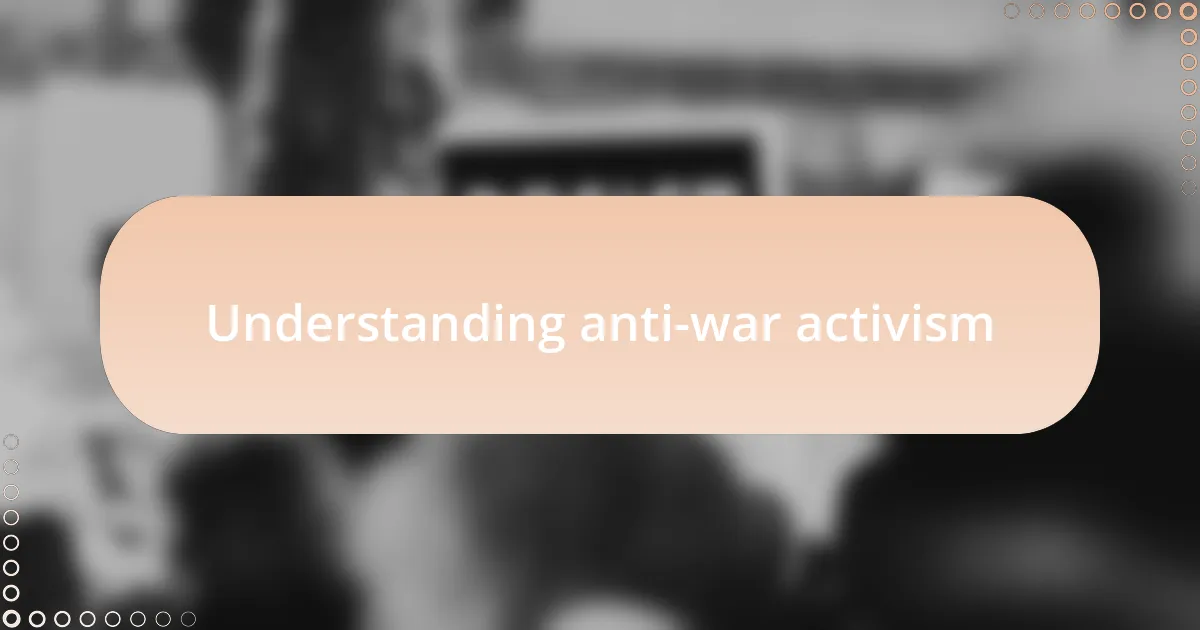
Understanding anti-war activism
Anti-war activism is rooted in the belief that war brings untold suffering to both soldiers and civilians. I recall a moment when I stood in a small community meeting, hearing a veteran share his experiences. His words hit me hard; they made me realize that behind the statistics of war are real lives forever changed. How often do we consider the personal stories behind the headlines about conflict?
Understanding anti-war activism also means recognizing its emotional landscape. I remember attending a peaceful march where the air was charged with hope and determination. As we chanted together, I felt an overwhelming sense of solidarity. It made me wonder: how can our collective voices reshape the narrative surrounding war? Each individual act can ripple outward, influencing larger societal views.
Moreover, anti-war activism often emphasizes the importance of dialogue and education. Reflecting on my own journey, I’ve realized how crucial it is to share knowledge about the consequences of war, not just in terms of human loss but also its impact on families and communities. Why is it that we often overlook these discussions, even in our closest circles? Engaging with one another about the realities of conflict is vital if we’re to foster a culture that prioritizes peace over violence.
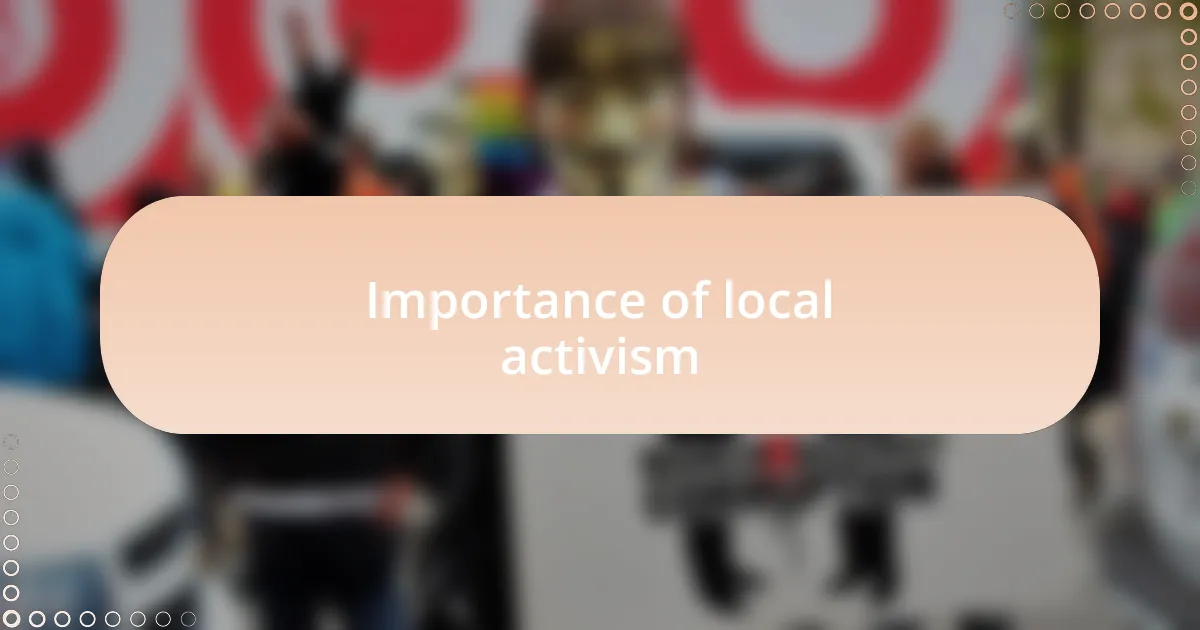
Importance of local activism
Local activism serves as a powerful foundation for broader movements, illuminating the unique challenges and concerns within our communities. I remember attending a local town hall, where residents shared their personal experiences with the repercussions of military actions. Hearing those firsthand accounts reminded me that activism starts right at home—where one person’s story can inspire others to join the cause. Isn’t it incredible how local voices can ignite a passion for change?
Moreover, local activism cultivates a sense of belonging and shared purpose. I often find myself connecting with neighbors who share similar values, and that connection strengthens our resolve. Together, we’ve organized events that not only raise awareness but also foster empathy and understanding. How often do we take the time to build these community ties, knowing they have the potential to amplify our efforts?
Ultimately, the importance of local activism lies in its ability to create direct and tangible change. In my experience, grassroots initiatives often yield results that larger, more distant movements might overlook. For instance, a campaign we spearheaded led to increased funding for veterans’ mental health services in our town. This achievement highlighted how local action can ripple outward, transforming lives and setting a precedent for other communities to follow. Why wait for change when we can initiate it ourselves?
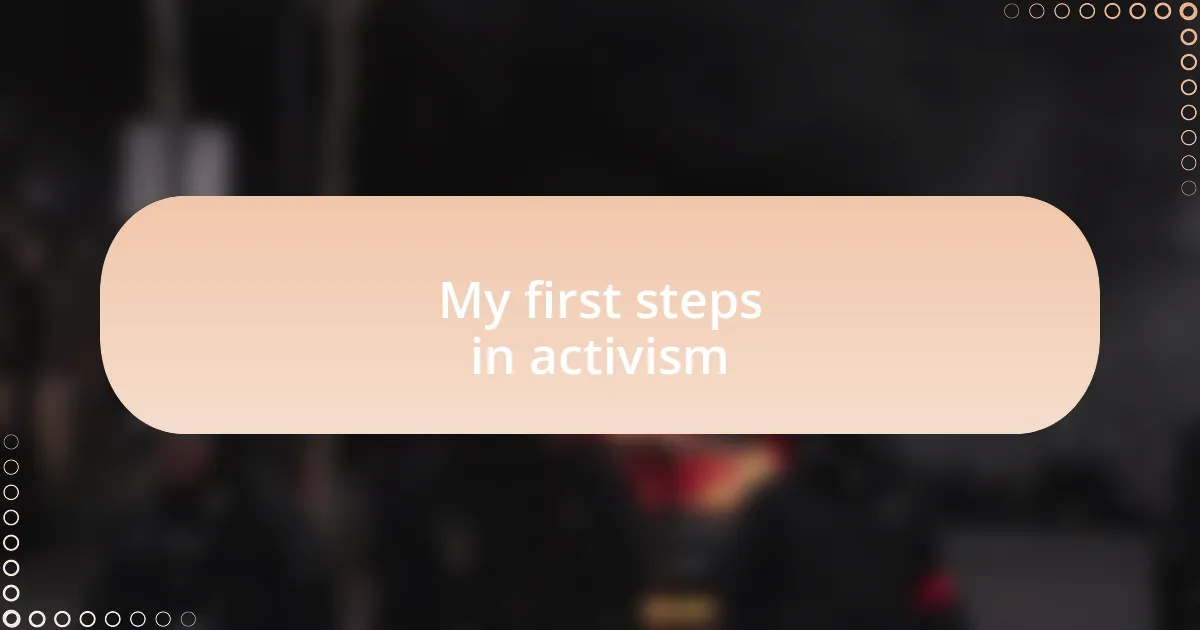
My first steps in activism
The first step I took into activism was surprisingly simple yet profound. I joined a small community group focused on addressing the impacts of military spending on local services. Sitting around that dimly lit table, I felt a sense of camaraderie as we discussed our shared concerns. Wasn’t it enlightening to see how our conversations morphed into actionable steps?
I vividly remember my first rally: a mix of excitement and nervousness coursing through me. There were chants, signs, and an electric atmosphere that was impossible to ignore. I still recall the powerful moment when a young woman spoke about the loss of her brother in combat, and tears welled in my eyes. How could one story resonate so deeply with a crowd? It was in that moment that I realized how each personal narrative contributes to a larger tapestry of activism.
As I dove deeper, I started organizing small information sessions in my neighborhood. Initially, I wasn’t sure if anyone would show up; however, the turnout exceeded my expectations. Neighbors I barely knew shared their own stories and insights, revealing how much we all craved a platform for our voices. I was struck by the realization that this journey wasn’t just about fighting against something; it was about building a community of passionate change-makers. How amazing is it that our collective experiences can fuel the fire for meaningful change?
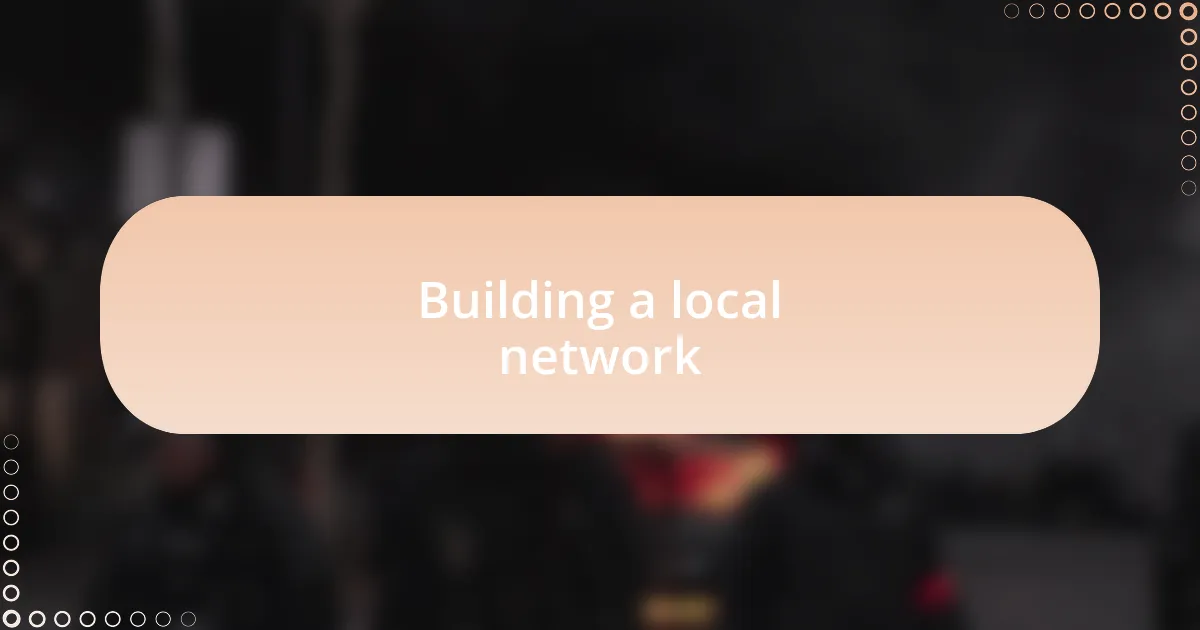
Building a local network
Building a local network started when I reached out to other activists in my area. It wasn’t just about gathering names; it was about making genuine connections. I still remember my first coffee chat with a veteran activist who had decades of experience. Her stories were rich with trials and triumphs. Could I ever achieve the kind of impact she had? She reassured me that every effort counts, no matter how small.
As we expanded our circle, I found myself attending local events, such as workshops and town hall meetings. Each gathering was a lesson in solidarity and empowerment. I met people from diverse backgrounds, united by a common goal. There’s something profoundly uplifting about sharing a space with others who understand your passion. How could I have been so unaware of this network just waiting to be tapped into?
Creating an inclusive environment became a priority for me, as I recognized the need for a variety of voices in our discussions. One day, while sitting in a park with a group of newcomers, I realized we were all eager to learn from each other. Their fresh perspectives invigorated my own understanding. It dawned on me that building a local network isn’t merely about numbers; it’s about cultivating trust and collaboration among individuals who truly care. How powerful is it when everyone feels valued and heard?
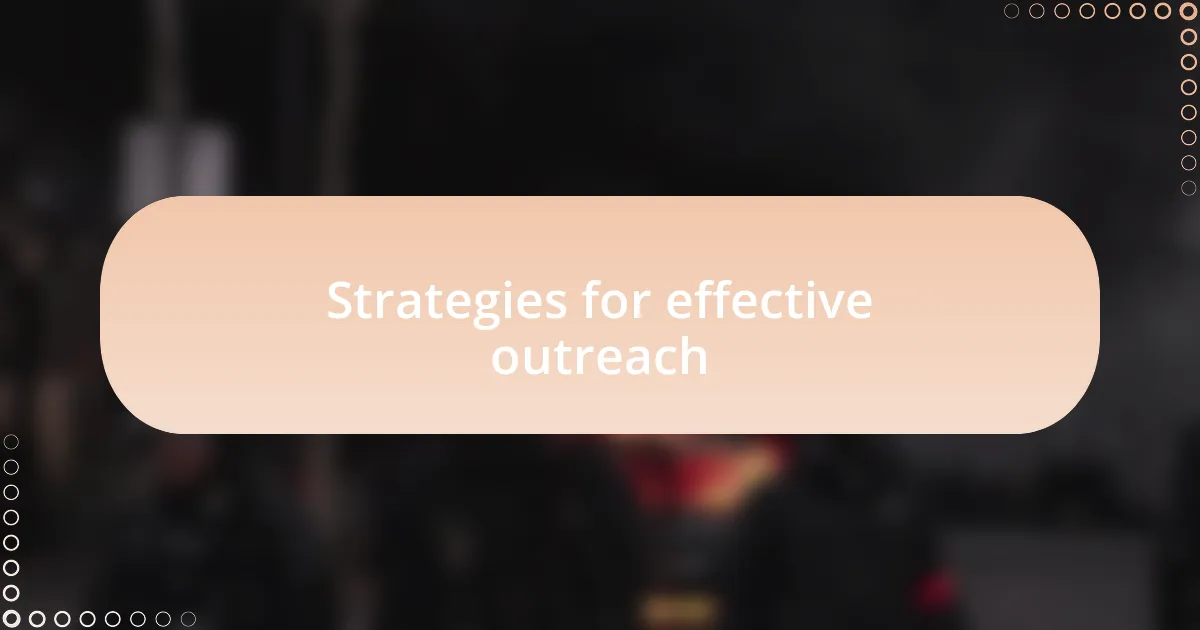
Strategies for effective outreach
Effective outreach requires more than just information dissemination; it thrives on personal connection. I once organized a neighborhood potluck to discuss our anti-war initiatives. What struck me was how sharing a meal transformed strangers into friends, allowing candid conversations to flow. Isn’t it amazing how a simple act like breaking bread can open hearts and minds?
Utilizing social media strategically has also proven instrumental in our outreach efforts. I remember posting a heartfelt video about a local protest, sharing not just facts but my emotions surrounding it. The response was overwhelming; people felt compelled to engage and share their own stories. It made me realize: authentic narratives resonate deeply and can ignite a community’s passion for change.
I’ve found that tailoring your message to fit your audience is crucial. When speaking with community members who may not be as familiar with anti-war sentiments, I focus on how these issues affect our daily lives. For instance, I once spoke at a local high school, emphasizing the impact of military funding on education. The students responded with such enthusiasm, and it reminded me that by drawing connections to their experiences, we empower them to advocate for their future. How impactful can our words be when we relate them directly to someone’s reality?

Engaging the community
Engaging the community is about creating spaces where people feel heard. I once hosted a community workshop at a local library, inviting residents to share their experiences related to military actions and its effects on our neighborhoods. The stories that came out that day were powerful and raw, and it made me realize that listening is just as vital as speaking. Have you ever considered how much wisdom lies within your local community?
Building partnerships with existing community organizations can amplify our outreach efforts. For example, I collaborated with a local youth group that was already passionate about social justice. Together, we organized an art exhibit where young artists expressed their thoughts on peace and conflict. This not only engaged the youth but also drew in their families and peers, showing me the ripple effect of collective action. Isn’t it incredible how collaboration can inspire a wider audience?
Moreover, I’ve found that incorporating fun, interactive elements into events can draw people in. One time, we held a community game night that centered around anti-war trivia. It was a surprising success! Not only did it spur lively discussions, but it also created a relaxed atmosphere for people to learn and connect. How often do we associate learning with fun, and yet, it can be the perfect setting for serious conversations?
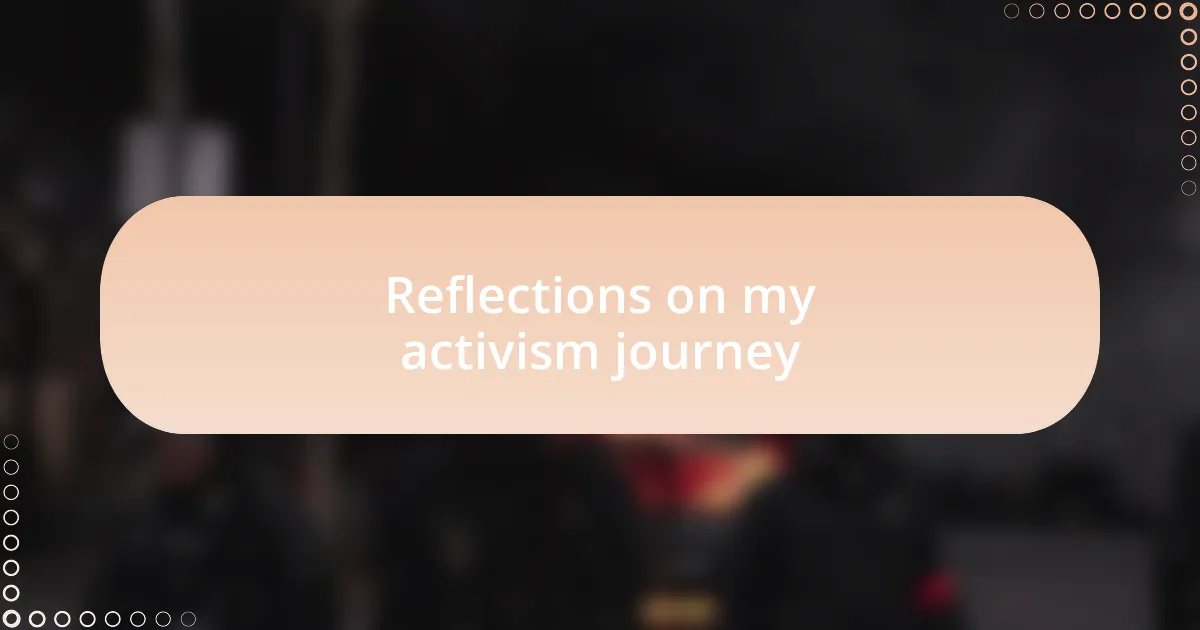
Reflections on my activism journey
Reflecting on my activism journey, I often find myself revisiting the moments that shaped my perspective on peace. One particularly memorable experience was when I joined a local protest against military intervention. The energy was palpable, and standing shoulder to shoulder with others who shared my passion for non-violence was invigorating. Have you ever felt that rush of belonging when surrounded by like-minded individuals?
As I look back, the connections I’ve forged with fellow activists have profoundly influenced my beliefs. I remember late nights spent brainstorming strategies with a diverse group of people, each bringing unique perspectives to the table. These conversations not only challenged me but also deepened my understanding of the complexities surrounding war and peace. Isn’t it fascinating how dialogue can transform our viewpoints?
There have been challenges along the way, too. I faced moments of self-doubt when my efforts seemed insignificant in the grand scheme of things. Yet, each time I witnessed even the smallest change, whether it was someone reassessing their views or engaging in a new conversation, it revitalized my commitment to the cause. How do we measure progress in activism, if not through the heartbeats of those we touch?